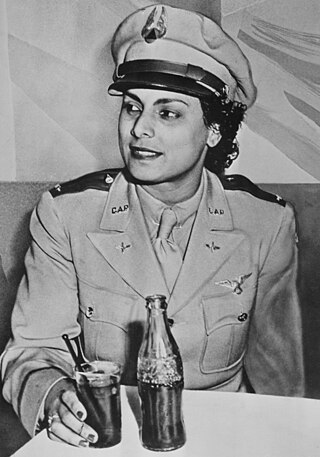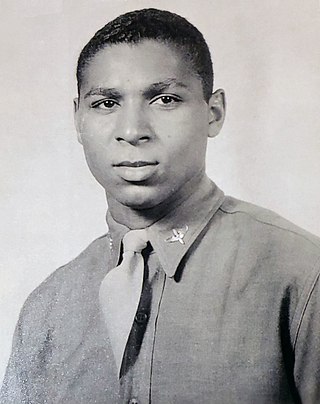Related Research Articles
The Tuskegee Airmen was a group of primarily African American military pilots and airmen who fought in World War II. They formed the 332nd Fighter Group and the 477th Bombardment Group (Medium) of the United States Army Air Forces (USAAF). The name also applies to the navigators, bombardiers, mechanics, instructors, crew chiefs, nurses, cooks, and other support personnel. The Tuskegee airmen received praise for their excellent combat record earned while protecting American bombers from enemy fighters. The group was awarded three Distinguished Unit Citations.

Robbins is a village southwest of Chicago in Cook County, Illinois, United States. The population was 4,629 at the 2020 census. It is the second oldest African American incorporated town in the north following Brooklyn, Illinois, and was home to the country’s first black-owned airport, Robbins Airport.

The Freeman Field mutiny was a series of incidents at Freeman Army Airfield, a United States Army Air Forces base near Seymour, Indiana, in 1945 in which African American members of the 477th Bombardment Group attempted to integrate an all-white officers' club. The mutiny resulted in 162 separate arrests of black officers, some of them twice. Three were court-martialed on relatively minor charges. One, Roger C. Terry, was convicted. In 1995, the Air Force officially vindicated the actions of the African-American officers, set aside the single court-martial conviction and removed letters of reprimand from the permanent files of 15 of the officers. The mutiny is generally regarded by historians of the Civil Rights Movement as an important step toward full integration of the armed forces and as a model for later efforts to integrate public facilities through civil disobedience.

Tuskegee Airmen National Historic Site, at Moton Field in Tuskegee, Alabama, commemorates the contributions of African-American airmen in World War II. Moton Field was the site of primary flight training for the pioneering pilots known as the Tuskegee Airmen, and is now operated by the National Park Service to interpret their history and achievements. It was constructed in 1941 as a new training base. The field was named after former Tuskegee Institute principal Robert Russa Moton, who died the previous year.

Sharpe Field is a closed private use airport located six nautical miles northwest of the central business district of Tuskegee, a city in Macon County, Alabama, United States. This airport is privately owned by the Bradbury Family Partnership.
The Columbia Air Center was an airfield in Croom, Maryland from 1941 to 1958. It was started by African American pilots who were not permitted to use other airports, but was also open to whites. It had an all black staff, and a number of the trainers had served in World War II as Tuskegee Airmen.
Isaiah Edward Robinson Jr. was the first African-American president of the New York City Board of Education. He chaired the Board's Decentralization Committee from May, 1969 to April, 1970. Robinson graduated from the Tuskegee Institute Flight School on November 20, 1945 and was one of the Documented Original Tuskegee Airmen (DOTA).
Janet Harmon Waterford Bragg was an American amateur aviator. In 1942, she was the first African-American woman to hold a commercial pilot license. She is a 2022 inductee to the Georgia Aviation Hall of Fame.

Willa Beatrice Brown was an American aviator, lobbyist, teacher, and civil rights activist. She was the first African American woman to earn a pilot's license in the United States, the first African American woman to run for the United States Congress, first African American officer in the Civil Air Patrol, and first woman in the U.S. to have both a pilot's license and an aircraft mechanic's license.

Noel Francis Parrish was an American brigadier general in the United States Air Force who was the white commander of a group of black airmen known as the Tuskegee Airmen during World War II. He was a key factor in the program's success and in their units being assigned to combat duty. Parrish was born and raised in the south-east United States; he joined the U.S. Army in 1930. He served in the military from 1930 until 1964, and retired as a brigadier general in 1964.

John Charles Robinson was an American aviator and activist who was hailed as the "Brown Condor" for his service in the Imperial Ethiopian Air Force against Fascist Italy. Robinson pushed for equal opportunities for African-Americans during his early career, and was able to open his own eponymous aviation school in addition to initiating a program for black pilots at his college, the Tuskegee Institute. Robinson's achievements as an aviator were in stark contrast to the limited opportunities for most African-Americans in aviation careers, and were an important factor in reducing racially based prohibitions in the United States. Robinson is sometimes referred to as the "Father of the Tuskegee Airmen" for inspiring this all-black group of pilots who served in the United States Army Air Forces following the United States' entry into World War II.

Oscar Lawton Wilkerson was an American pilot and radio personality. He was one of the Tuskegee Airmen, a group of African American aviators and support personnel who served during World War II.
Cornelius Robinson Coffey was an American aviator. Alongside Willa Brown, he was the first African American to create a non-university-affiliated aeronautical school in the United States.
Quentin P. Smith (1919–2013) was an American airman who served as a B-25 bombardier with the Tuskegee Airmen during World War II.

First Lieutenant Robert L. Martin (WIA) was a Tuskegee Airman active during World War II. His aircraft was shot down after a raid on an airfield in Yugoslavia. He was a recipient of the Distinguished Flying Cross.
Prentice Herman Polk was an American photographer known for his portraits of African Americans. He also served for several years as head of the Tuskegee Institute's Department of Photography.

Curtiss–Wright Aeronautical University was a flight school in Chicago, Illinois founded by aircraft manufacturer Curtiss-Wright. Open from 1929 until 1953, the university was the first accredited flight school in the Midwest which accepted black students and instructors. While it opened as an all-white school, after Cornelius Coffey and John C. Robinson threatened to sue the school for denying them entrance in 1930, the superintendent agreed to conduct segregated classes for black students if the two could prove that enough black students would enroll. The two founded the Challenger Air Pilots Association to develop the city's black aviation community, and by 1932 they had organized enough people to begin an all-black class. When the school lost access to its original airfield in 1933, its black students opened their own field due to the discrimination they faced at the city's other fields; originally located in the black community of Robbins, it later moved to 87th Street and Harlem Avenue in Chicago. The school's students played an important role in both developing Chicago's black aviation community and fighting for equality and the growth of black aviation nationwide. Aside from Coffey and Robinson, its notable alumni included Willa Brown, Janet Bragg, and several of the Tuskegee Airmen.
The Coffey School of Aeronautics was a flight school at Harlem Airport in Oak Lawn, Illinois, founded by Cornelius Coffey and Willa Brown. It was the first flight school owned and operated by African-Americans in the United States. The school opened in 1940 and closed after World War II. While it was open, it trained African-American pilots as part of the Civilian Pilot Training Program; many of these pilots went on to join the Tuskegee Airmen.

Lincoln T. Hudson was a U.S. Army Air Force officer, World War II fighter pilot, Prisoner of War in Nazi Germany, and a corporate executive. During World War II, Hudson served in the all-African-American 332nd Fighter Group's 301st Fighter Squadron, best known as the all-African American combat fighter pilot group, the Tuskegee Airmen, "Red Tails," or among enemy German pilots, “Schwartze Vogelmenschen”.
John W. Rogers Sr. was an American attorney and military aviator. He served as a Cook County, Illinois Juvenile Court judge, attorney, U.S. Army Air Force/U.S. Air Force officer and combat fighter pilot with the 332nd Fighter Group's 99th Pursuit Squadron, best known as the Tuskegee Airmen or "Red Tails". He was one of the 1007 documented Tuskegee Airmen Pilots.
References
- ↑ O'Brien, Ken (November 5, 1995). "Flying Into History in Robbins". Chicago Tribune.
- ↑ "Two Black Pioneer Flyers Recall Early Days, Challenges". St. Louis Post-Dispatch. November 9, 1992.
- ↑ Poe, Janita (March 1, 1993). "Black woman broke double-edged barrier". Chicago Tribune.
- ↑ Tucker, Philip Thomas (2012). Father of the Tuskegee Airmen, John C. Robinson. Washington D.C.: Potomac Books.
- ↑ "Abandoned & Little-Known Airfields: Illinois: Western Chicago area". Airfields-freeman.com. 1994-07-24. Archived from the original on March 9, 2015. Retrieved 2022-08-03.
- ↑ McCall, Matt (February 13, 2017). "2 African-Americans soared from Robbins: Black pilots built their own plane, then their own airfield in village". Chicago Tribune.
- ↑ Tucker, Phillip Thomas (2012). Father of the Tuskegee Airmen, John C. Robinson. Washington, D.C.: Potomac Books. p. 46. ISBN 978-1597974875.
- ↑ "Potomac Books - Father of the Tuskegee Airmen, John C. Robinson". Potomacbooksinc.com. Retrieved 2014-08-25.
- ↑ Lambertson, Giles. 'The Other Harlem', Air & Space Smithsonian, 2010, vol. 24, no.7, pp. 54-59.
- ↑ "The Other Harlem".